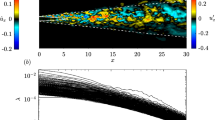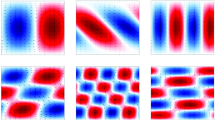Abstract
Turbulent dynamical systems are characterized by persistent instabilities which are balanced by nonlinear dynamics that continuously transfer energy to the stable modes. To model this complex statistical equilibrium in the context of uncertainty quantification all dynamical components (unstable modes, nonlinear energy transfers, and stable modes) are equally crucial. Thus, order-reduction methods present important limitations. On the other hand uncertainty quantification methods based on the tuning of the non-linear energy fluxes using steady-state information (such as the modified quasilinear Gaussian (MQG) closure) may present discrepancies in extreme excitation scenarios. In this paper we derive a blended framework that links inexpensive second-order uncertainty quantification schemes that model the full space (such as MQG) with high order statistical models in specific reduced-order subspaces. The coupling occurs in the energy transfer level by (i) correcting the nonlinear energy fluxes in the full space using reduced subspace statistics, and (ii) by modifying the reduced-order equations in the subspace using information from the full space model. The results are illustrated in two strongly unstable systems under extreme excitations. The blended method allows for the correct prediction of the second-order statistics in the full space and also the correct modeling of the higher-order statistics in reduced-order subspaces.










Similar content being viewed by others
References
DelSole, T.: Stochastic models of quasigeostrophic turbulence. Surv. Geophys. 25, 107–149 (2004)
Holmes, P., Lumley, J., Berkooz, G.: Turbulence, Coherent Structures, Dynamical Systems and Symmetry. Cambridge University Press, Cambridge (1996)
Kramers, H.A.: Brownian motion in a field of force and the diffusion model of chemical reactions. Physica 7, 284 (1940)
Lall, S., Marsden, J.E., Glavaski, S.: A subspace approach to balanced truncation for model reduction of nonlinear control systems. Int. J. Robust Nonlinear Control 12, 519 (2002)
Lorenz, E.: Predictability—a problem partly solved. In: Proceedings on Predictability, ECMWF, September, pp. 1–18 (1996)
Lorenz, E.N., Emanuel, K.A.: Optimal sites for supplementary weather observations: simulations with a small model. J. Atmos. Sci. 55, 399–414 (1998)
Ma, Z., Rowley, C.W., Tadmor, G.: Snapshot-based balanced truncation for linear time-periodic systems. IEEE Trans. Autom. Control 55, 469 (2010)
Majda, A.J., Harlim, J.: Filtering Complex Turbulent Systems. Cambridge University Press, Cambridge (2012)
Majda, A.J., Timofeyev, I., Vanden-Eijnden, E.: Models for stochastic climate prediction. Proc. Natl. Acad. Sci. 96, 14687 (1999)
Majda, A.J., Timofeyev, I., Vanden-Eijnden, E.: A mathematical framework for stochastic climate models. Commun. Pure Appl. Math. 54, 891 (2001)
Majda, A.J., Timofeyev, I., Vanden-Eijnden, E.: A priori tests of a stochastic mode reduction strategy. Physica D 170, 206 (2002)
Majda, A.J., Abramov, R.V., Grote, M.J.: Information Theory and Stochastics for Multiscale Nonlinear Systems. CRM Monograph Series, vol. 25. American Mathematical Society, Providence (2005)
Majda, A.J., Gershgorin, B., Yuan, Y.: Low-frequency climate response and fluctuation-dissipation theorems: theory and practice. J. Atmos. Sci. 67, 1186–1201 (2010)
Marcinkiewicz, J.: Sur une propriete de la Loi de Gauss. Math. Z. 44, 612 (1938)
Moyal, J.E.: Stochastic processes and statistical physics. J. R. Stat. Soc. B 11, 150 (1949)
Pawula, R.F.: Approximation of the linear Boltzmann equation by the Fokker-Planck equation. Phys. Rev. 162, 186 (1967)
Sapsis, T.P.: Attractor local dimensionality, nonlinear energy transfers, and finite-time instabilities in unstable dynamical systems with applications to 2D fluid flows. Proc. R. Soc. A 469, 20120550 (2013)
Sapsis, T.P., Lermusiaux, P.F.J.: Dynamically orthogonal field equations for continuous stochastic dynamical systems. Physica D 238, 2347–2360 (2009)
Sapsis, T.P., Lermusiaux, P.F.J.: Dynamical criteria for the evolution of the stochastic dimensionality in flows with uncertainty. Physica D 241, 60 (2012)
Sapsis, T.P., Majda, A.J.: Blended reduced subspace algorithms for uncertainty quantification of quadratic systems with a stable mean state. Physica D (2013a). doi:10.1016/j.physd.2013.05.004
Sapsis, T.P., Majda, A.J.: A statistically accurate modified quasilinear Gaussian closure for uncertainty quantification in turbulent dynamical systems. Physica D 252, 34–45 (2013b)
Sirovich, L.: Turbulence and the dynamics of coherent structures, parts I, II and III. Q. Appl. Math. XLV, 561–590 (1987)
Ueckermann, M.P., Lermusiaux, P.F.J., Sapsis, T.P.: Numerical schemes for dynamically orthogonal equations of stochastic fluid and ocean flows. J. Comput. Phys. 233, 272–294 (2013)
Acknowledgements
We would like to thank the referees for useful comments and suggestions. The research of A. Majda is partially supported by NSF grant DMS-0456713, NSF CMG grant DMS-1025468, and ONR grants ONR-DRI N00014-10-1-0554, N00014-11-1-0306, and ONR-MURI N00014-12-1-0912. T. Sapsis is supported as postdoctoral fellow by the first and third grants.
Author information
Authors and Affiliations
Corresponding author
Additional information
Communicated by A. Stuart.
Rights and permissions
About this article
Cite this article
Sapsis, T.P., Majda, A.J. Blending Modified Gaussian Closure and Non-Gaussian Reduced Subspace Methods for Turbulent Dynamical Systems. J Nonlinear Sci 23, 1039–1071 (2013). https://doi.org/10.1007/s00332-013-9178-1
Received:
Accepted:
Published:
Issue Date:
DOI: https://doi.org/10.1007/s00332-013-9178-1
Keywords
- Blended stochastic methods
- Modified quasilinear Gaussian closure
- Dynamical orthogonality
- Uncertainty quantification in reduced order subspaces




